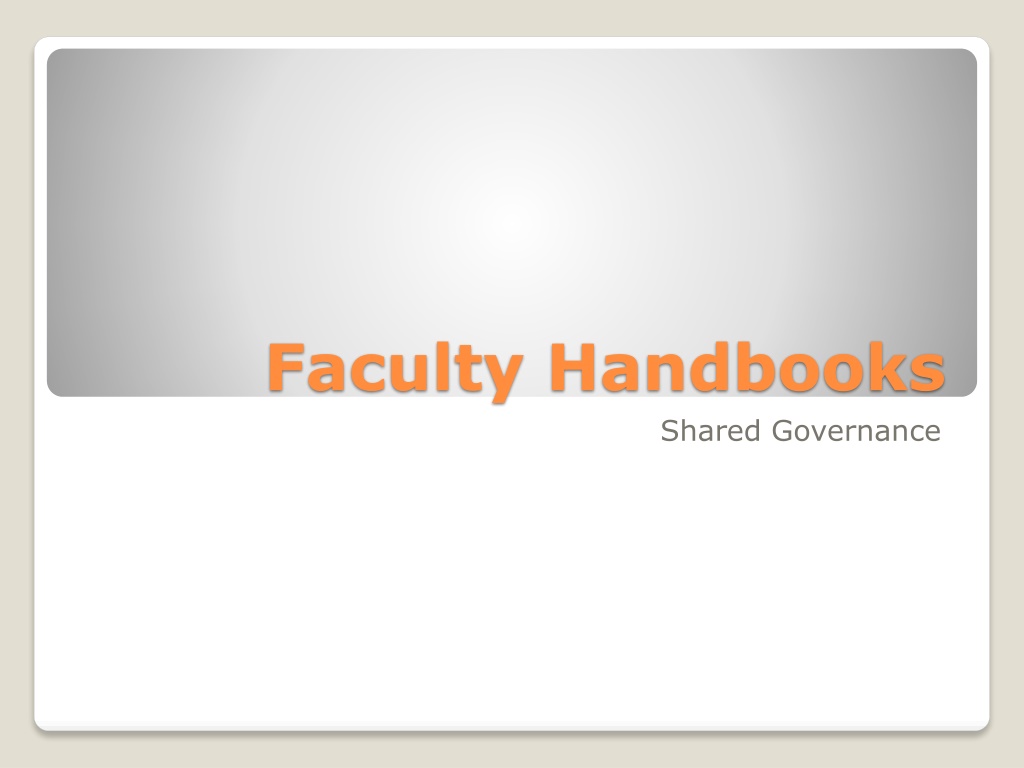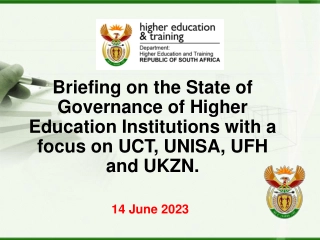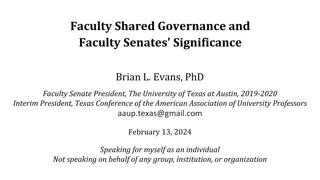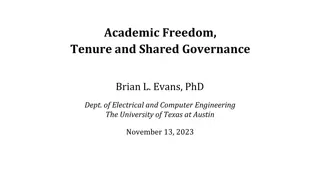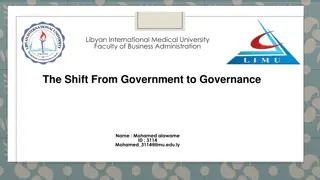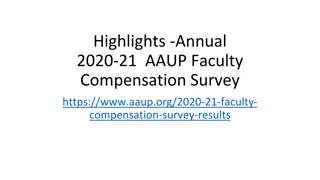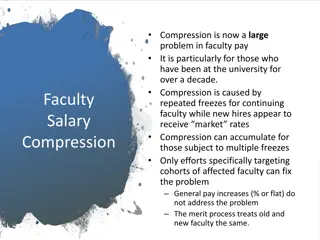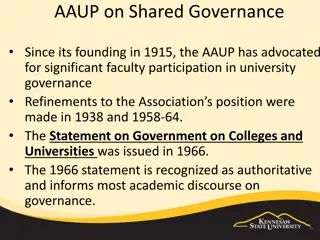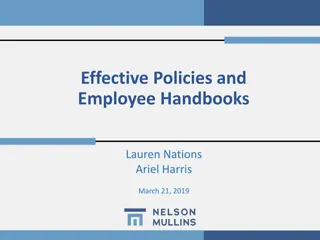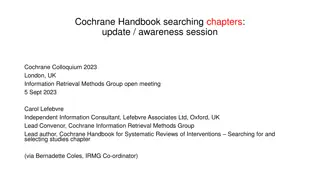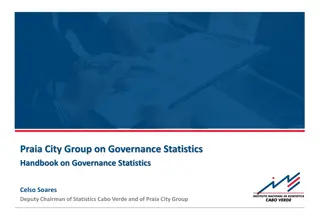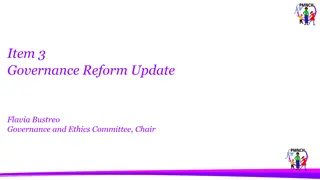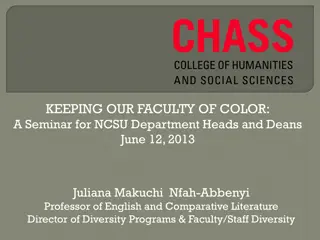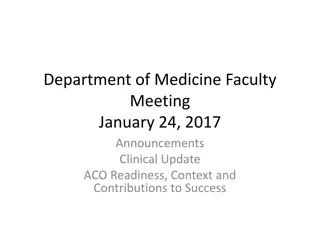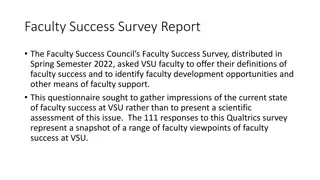Understanding Faculty Handbooks and Shared Governance in Higher Education
College and university handbooks play a crucial role in faculty members' employment contracts and academic responsibilities. Faculty handbooks cover a wide range of topics from governance structure to employment rights. Shared governance aims to reduce confusion by involving faculty, administration, and stakeholders in decision-making processes. Faculty members in higher education hold primary responsibility for determining curriculum, academic standards, and colleagues' status. Revising handbooks regularly is recommended to keep policies up to date. Contract agreements take precedence over handbook contents.
- Faculty Handbooks
- Shared Governance
- Higher Education
- Academic Responsibilities
- Contractual Agreements
Download Presentation

Please find below an Image/Link to download the presentation.
The content on the website is provided AS IS for your information and personal use only. It may not be sold, licensed, or shared on other websites without obtaining consent from the author. Download presentation by click this link. If you encounter any issues during the download, it is possible that the publisher has removed the file from their server.
E N D
Presentation Transcript
Faculty Handbooks Shared Governance
College and university handbooks touch on a broad array of issues, from the composition of an institution's governance structure to how leave requests are granted. Faculty Handbooks
A faculty handbook can also be an integral part of a faculty member's employment contract--but its enforceability can differ from state to state, or institution, Sometimes causing confusion and uncertainty for faculty members facing administrative actions that affect the whole school or questions about their individual employment status.
One way to avoid confusion is to use shared governance Shared governance is meant to change all the confusion by bringing faculty, administration, and other stakeholders to the same planning table.
Faculty members in higher education should have primary responsibility to: Determine the curriculum, subject matter, methods of instruction, and other academic standards and processes. Establish the requirements for earning degrees and certificates, and authorize the administration and governing board to grant same. Exercise, where the faculty deems it appropriate, primary responsibility for determining the status of colleagues, especially appointment, reappointment, and tenure. Establish procedures for awarding promotions, sabbaticals, research support, and other rewards or perquisites. Faculty should along with their CAO* * Association of Governing Boards in December 2009 in the Advancing Higher Education series.
Chief academic officers specifically mentioned the need for up-to-date faculty handbooks. Revising handbooks regularly, as problems are identified and board policies and faculty resolutions are passed, was one suggestion to avoid the nearly overwhelming task of occasional and massive updating. Those who described it as a living document seemed most satisfied. The process of making changes was considered a valuable educational experience, for trustees and faculty. Daniel P. Nadler , Organizational Performance Through Staff Governance: Improving Shared Governance in the Higher Education Environment . Spring 2010
Contract trumps handbook Contents: Academic Freedom Mission Contracts and benefits Evaluations Teaching responsibilities Office Hours Nonteaching responsibilities Faculty Advising (new last year) Community Involvement LLTC Faculty Handbook
Textbooks Faculty Development CEU requirements Cultural class requirements Research and publishing Technology use Faculty development funds LLTC Handbook cont.
Academics Course scheduling Cultural components New course approval procedure Educational Program Course numbers Faculty Conduct Student Attendance Student Grading LLTC Handbook cont.
Work in groups for about 15 minutes to discuss: 1. Your institutions faculty handbook components 2. Whether faculty are involved in writing their handbook 3. What could we add or do better with our faculty handbooks? What is in your Faculty Handbook?
Groups report out Discussion
Among the most commonly cited barriers is inadequate time. This is mentioned in regard to trustees, faculty, and administrators. Faculty work load, busy board meeting agendas, distance of trustees from campus, complexity of issues, and urgency of budget decisions are all factors. The lack of mutual understanding and respect is another obstacle. Pejorative views, role confusion, minimal interaction, and lack of information perpetuate stereotypes and make it harder to reach agreement on decisions, especially in a difficult economic environment. Governance policies and practices that aren t accessible, up-to-date, or understood create confusion about process and roles and hamper governance. Barriers
Higher education is a complex industry. Navet about the culture of the academy, on one hand, and the business of running a multi-million (or billion) dollar college or university, on the other, is evident. There is an enormous amount to learn in order to govern well. Interaction is hampered by presidents who can t or won t engage boards and faculty. The quality of interaction communication, understanding, and work accomplished is dependent upon the president. It takes the interest and support of all parties to make it work, but interaction in governance work can be thwarted by a president who doesn t see the value or is unable to overcome existing problems. In addition to some uncommitted presidents, there is a lack of interest among some trustees and faculty. This means there is neither the will to commit the needed time and energy, nor the best people attracted to serve in governance positions. Comments Barriers
Most colleges and universities (90%) have an institution-wide faculty governing body and describe its role as policy-influencing (59%); less common is a role that is advisory (29%) or policy-making (13%). The influence of the faculty governing body is described by most as either important (50%) or very important (42%). Faculty governing bodies were more often described as advisory in public institutions (40%) than in private institutions (26%), and more often described as very important in independent institutions (44%) than in public institutions (32%). While many critics have expressed concern regarding faculty senates that lack influence, these presidents, chief academic officers, and board chairs said they are ubiquitous and influential. TIAA-CREF Institute in December 2009 in the Advancing Higher Education series.
